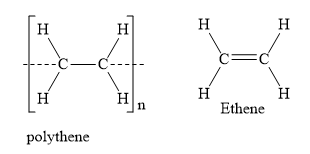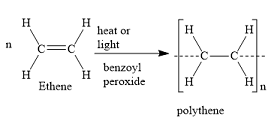
Distinguish between the terms homopolymer and copolymer and give an example of each.
Answer
574.8k+ views
Hint: The Classification homopolymer and copolymer is based on the number of different types of monomer units present in a polymer. In other words homopolymer and copolymer differ whether only one type of monomer unit is present or more than one type of monomer units are present.
Complete step by step answer:
There are different ways in which polymers are classified. One classification is based on the number of different types of monomer units present in a polymer. On this basis, the polymers can be classified into homopolymer and copolymer.
Note:
Homopolymer is usually an additional polymer whereas copolymer is usually a condensation polymer.
Complete step by step answer:
There are different ways in which polymers are classified. One classification is based on the number of different types of monomer units present in a polymer. On this basis, the polymers can be classified into homopolymer and copolymer.
| Homopolymer | Copolymer |
| Homopolymer is made from only one type of monomer unit. In the repeating structural unit of a homopolymer, only one type of monomer unit is present. | On the other hand, copolymer is made from two (or more) types of monomer units. In the repeating structural unit of a copolymer, two (or more) types of monomer unit are present. |
| Polythene, Teflon, PAN and nylon-6 are some examples of homopolymers. Thus, polythene is made from only one type of monomer unit which is ethylene. | Buna-S, Buna-N, polyester, Bakelite and nylon-6,6 are some examples of copolymers. Thus, buna-S is made from two types of monomer units which are styrene and 1,3-butadiene. |
The structure of polythene and its monomer are as shown below:
| The structure of buna S and its monomers are as shown below:
|
The reaction for the preparation of polythene is as shown below:
| The reaction for the preparation of buna-S is as shown below:
|
Note:
Homopolymer is usually an additional polymer whereas copolymer is usually a condensation polymer.
Recently Updated Pages
Master Class 12 Business Studies: Engaging Questions & Answers for Success

Master Class 12 Economics: Engaging Questions & Answers for Success

Master Class 12 English: Engaging Questions & Answers for Success

Master Class 12 Maths: Engaging Questions & Answers for Success

Master Class 12 Social Science: Engaging Questions & Answers for Success

Master Class 12 Chemistry: Engaging Questions & Answers for Success

Trending doubts
What are the major means of transport Explain each class 12 social science CBSE

Which are the Top 10 Largest Countries of the World?

Draw a labelled sketch of the human eye class 12 physics CBSE

How much time does it take to bleed after eating p class 12 biology CBSE

Explain sex determination in humans with line diag class 12 biology CBSE

Differentiate between homogeneous and heterogeneous class 12 chemistry CBSE




